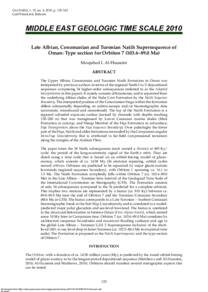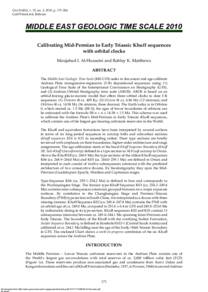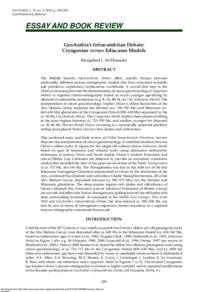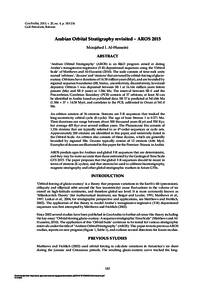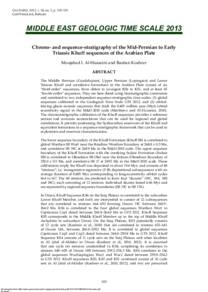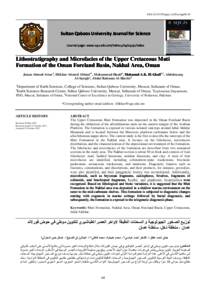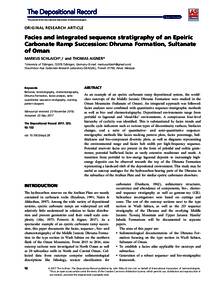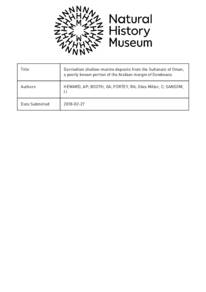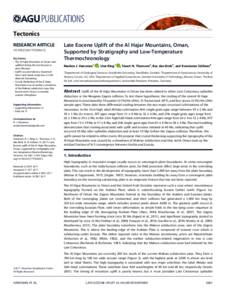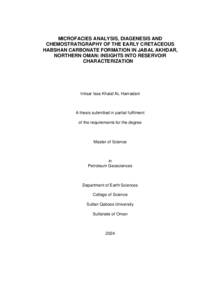Document
Late albian, cenomanian and turonian Natih supersequence of Oman : type section for Orbiton 7 (103.6-89.0 Ma).
Identifier
DOI: 10.2113/geoarabia1504125
Publisher
Gulf Petrolink.
Gregorian
2010-10
Language
English
Subject
English abstract
The Upper Albian, Cenomanian and Turonian Natih Formation in Oman was interpreted by previous authors in terms of the regional Natih I to V depositional sequences comprising 34 higher-order subsequences (referred to as the Adopted Interpretation in this paper). It mainly consists of limestones, and is separated from the underlying Albian shales of the Nahr Umr Formation by the Natih Sequence Boundary. The interpreted position of the Cenomanian Stage within the formation differs substantially depending on carbon-isotope and /or biostratigraphic data (ammonite, microfaunal and nannofossil). The top of the Natih Formation is a regional subaerial exposure surface (incised by channels with depths reaching 150-200 m) that was transgressed by Lower Coniacian marine shales (Muti Formation at outcrop, and Shargi Member of the Fiqa Formation in subsurface; Fiqa Transgression above the Fiqa Sequence Boundary). Over paleohighs the lower part of the Fiqa, Natih and older formations are eroded by the Campanian angular Intra-Fiqa Unconformity that is attributed to far-field compressional tectonism along the margins of the Arabian Plate. The paper tunes the 34 Natih subsequences (each named a Straton) at 405 Ky/ cycle: the period of the long-eccentricity signal of the Earth's orbit. They are dated using a time scale that is based on an orbital-forcing model of glacioeustasy, which consists of ca. 14.58 My (36 stra tons) repeating, orbital cycles named orbitons. Orbitons are predicted to be separated by major glacio-eustatic lowstands (regional sequence boundary), with Orbiton 1 spanning ca. 16.1 to 1.5 Ma. The Natih Formation completely falls within Orbiton 7 (ca. 103.6-89.0 Ma) in the Late Albian - Turonian time interval of the Geological Time Scale of the International Commission on Stratigraphy (GTS). The Formation consists of only 34 subsequences (compared to the 36 predicted for a complete orbiton). This implies two stratons are represented by a hiatus (ca. 810 Ky) between ca. 89.8-89.0 Ma near the end of Orbiton 7 and the Turonian/Coniacian boundary (88.6 Ma in GTS). The hiatus corresponds to a Late Turonian - Pearliest Coniacian biostratigraphic break at the Sub-Fiqa Unconformity and is correlated to a modelpredicted major polar glaciation and sea-level lowstand. The hiatus is unrelated to the structural deformation in Interior Oman (First Alpine Event), which started some 10 My later in Campanian time. Orbiton 7 (ca. 103.6-89.0 Ma) correlates by architecture (sequence boundaries and maximum flooding surfaces) and age to the global Late Albian - Turonian UZA 2 Supersequence inclusive of the short-lived 100+ m sea-level drop in latest Turonian (ca. 102.5-88.6 Ma in empirical time scale). The Formation is proposed as the Natih Supersequence and the type section of Orbiton 7.
Member of
ISSN
1025-6059
Resource URL
Category
Journal articles

